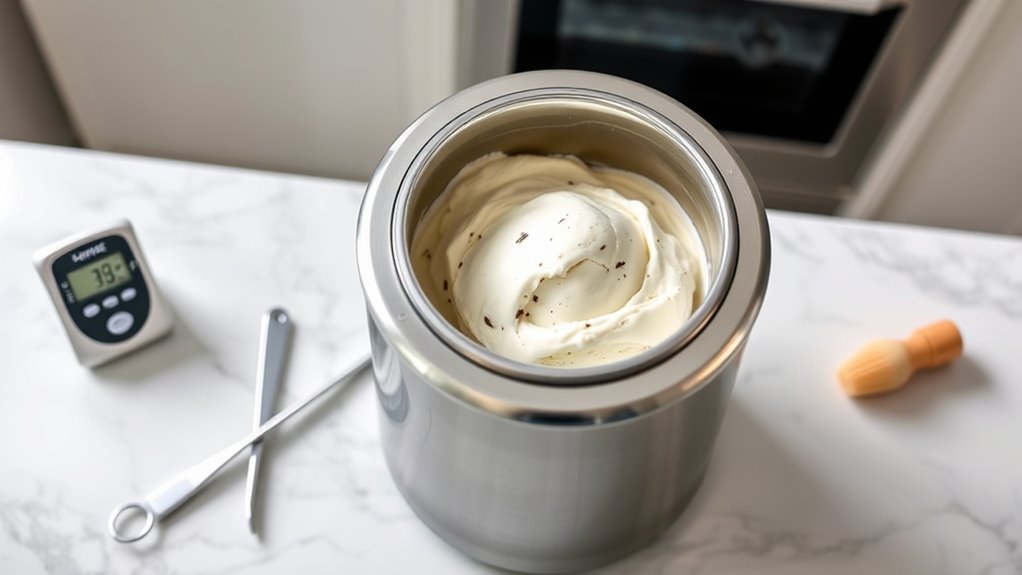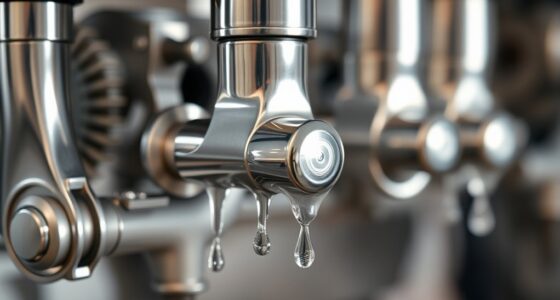To make certain your ice cream maker is safe, check its build quality, materials, and for any signs of damage like cracks or frayed cords. Follow proper cleaning routines, store it correctly, and always adhere to the manufacturer’s instructions. Watch for warning signs of wear or electrical issues, and replace the unit if needed. Staying vigilant helps prevent hazards and keeps your machine in top shape—more tips on safe use await you.
Key Takeaways
- Ensure your ice cream maker has proper safety certifications (UL, CE) and is free from visible damage or cracks.
- Regularly clean removable parts with warm, soapy water and dry thoroughly to prevent mold and bacteria buildup.
- Follow the manufacturer’s assembly and operation instructions carefully to avoid electrical hazards and leaks.
- Check for signs of wear or damage, such as frayed cords or strange noises, and replace or repair as needed.
- Store and operate the machine in a cool, dry environment, maintaining proper temperature and using food-grade containers for safety.
Inspecting the Build and Material Safety of Your Machine
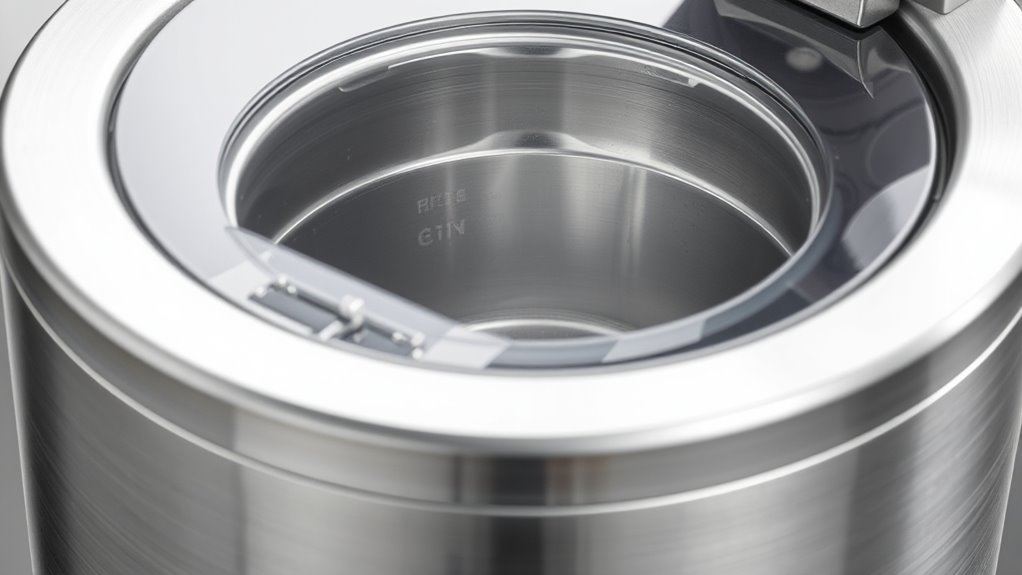
Before using your ice cream maker, it’s essential to carefully inspect its build and materials to guarantee safety. Check the material durability to ensure the components won’t crack, warp, or degrade over time, especially with frequent use or exposure to cold temperatures. Look for signs of wear or damage, like loose parts or cracks, which could compromise safety. Additionally, verify that your machine has proper safety certifications, such as UL or CE marks, indicating it meets industry safety standards. These certifications ensure the device has undergone testing for electrical safety and overall construction. Also, consider the power source and how it integrates with your electrical system to prevent potential hazards. Ensuring that your appliance adheres to regulatory frameworks can help prevent accidents and electrical issues. Regularly checking the materials used in your ice cream maker can help identify any potential safety risks early on. Being aware of material safety standards can further provide assurance that your appliance is constructed with health-conscious and durable materials. Understanding the technology involved in your ice cream maker can also help you identify any hidden safety concerns. Prioritizing a sturdy build and certified safety features helps prevent accidents, electrical issues, or contamination, giving you peace of mind while enjoying your favorite frozen treats.
Proper Cleaning and Maintenance Procedures
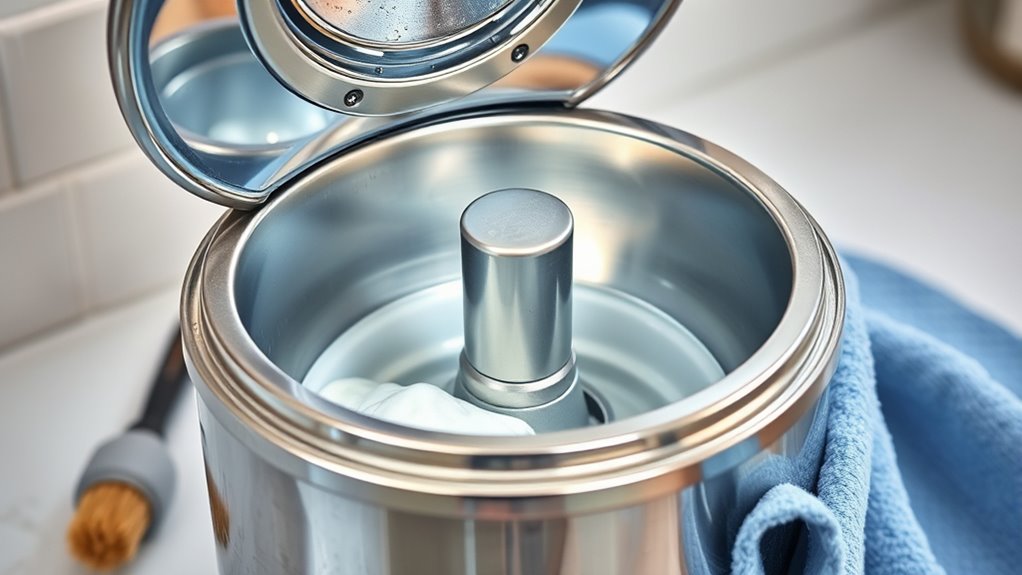
Regular cleaning and maintenance are essential to keep your ice cream maker running safely and efficiently. To guarantee proper sanitization practices, wash all removable parts with warm, soapy water after each use, paying close attention to crevices and seals. Rinse thoroughly and dry completely to prevent mold and bacteria growth. For long-term storage, follow storage tips like wrapping the machine or components in clean, dry cloths and storing them in a cool, dry place. Avoid leaving leftover ingredients or water inside the machine, as these can cause spoilage or damage. Regularly inspect parts for wear or cracks and replace them as needed. Proper cleaning and storage not only extend your machine’s lifespan but also protect you from potential health risks. Additionally, ensuring the proper pressure is maintained during operation can help prevent damage and improve performance. Incorporating a durable survival gear checklist can help you keep all maintenance tools organized and accessible, reducing the risk of missing essential steps. Using proper cleaning tools designed for small appliances can make maintenance easier and more effective. For optimal results, consider using antibacterial cleaning agents that are safe for food-contact surfaces to further reduce microbial contamination. Remember that choosing a HEPA filter for air purification can significantly improve air quality in your environment, supporting overall health.
Understanding the Manufacturer’s Safety Guidelines
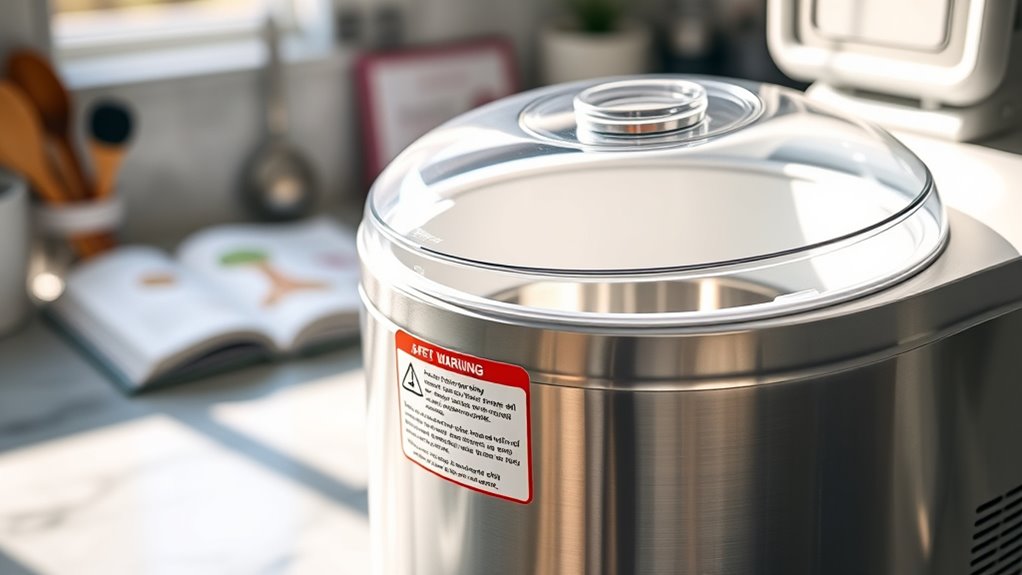
You should carefully read the instruction manual before using your ice cream maker to understand all safety features. Make sure to follow the assembly instructions exactly to prevent accidents or damage. Also, stick to the manufacturer’s maintenance recommendations to keep your machine safe and functioning properly. Regularly inspecting your appliance for any wear or damage can also help ensure ongoing safety and performance for optimal use. Additionally, being aware of product buildup removal techniques can help maintain your machine’s cleanliness and efficiency, which is essential for supporting the mind-body connection and overall safety during operation. Incorporating health benefits of frozen yogurt awareness can motivate proper cleaning habits. Remember that grocery savings strategies can also be applied to purchasing cleaning supplies, ensuring you keep your appliance in top condition without overspending.
Read Instruction Manual Carefully
Reading the instruction manual thoroughly is essential to guarantee safe and proper use of your ice cream maker. It provides crucial information about ingredient safety, ensuring you use safe, approved ingredients to prevent contamination or equipment damage. The manual also highlights storage precautions, guiding you on how to store parts and ingredients correctly to maintain hygiene and prolong your machine’s lifespan. Proper filter maintenance and regular replacements, as outlined in the manual, are vital for optimal performance and safety. Ignoring these guidelines can lead to accidents, spoilage, or malfunction. Additionally, understanding safety warnings and proper handling procedures can help prevent common issues and ensure a smooth operation. Being aware of proper handling procedures helps in reducing the risk of injury or damage during use. Proper vehicle tuning can also help optimize the performance and safety of your appliance, ensuring it operates efficiently and reliably. Familiarizing yourself with manufacturer instructions can further reduce risks by providing detailed troubleshooting tips and maintenance schedules. This simple step helps protect your health, your investment, and your enjoyment of delicious homemade ice cream.
Follow Assembly Procedures Precisely
To guarantee safe and effective operation, it is crucial to follow the assembly procedures exactly as outlined by the manufacturer. Proper assembly safety depends on your adherence to the user instructions. Skipping steps or improvising can lead to malfunctions or safety hazards. Carefully read each step and double-check connections before powering on. Use the following table as a quick reference:
| Step | Important Tip |
|---|---|
| Attach components securely | Prevent leaks and accidents |
| Follow wiring instructions | Avoid electrical hazards |
| Use recommended tools | Ensure proper assembly |
| Confirm all parts are in place | Maintain safety and efficiency |
Additionally, understanding the fundamentals of electrical safety can help prevent hazards during assembly and operation. Familiarizing yourself with home improvement safety practices can further ensure a secure setup. Being aware of proper handling of electrical components is essential to avoid shocks and damage. Knowing how to recognize potential safety risks during assembly can help you address issues promptly and maintain overall safety.
Adhere to Maintenance Recommendations
Adhering to the manufacturer’s maintenance recommendations is essential for ensuring your ice cream maker operates safely and efficiently. Follow the recommended cleaning routines to prevent mold, bacteria, or residue buildup that could compromise safety or affect taste. Always unplug the machine before cleaning and use gentle, non-abrasive cleaners. Additionally, pay attention to storage tips—store parts in a dry, cool place, and ensure all components are completely dry before reassembling or storing. Proper maintenance extends the lifespan of your ice cream maker and reduces the risk of malfunctions or safety hazards. Regularly inspecting parts and complying with the manufacturer’s guidelines guarantees your appliance remains in top condition, delivering safe, delicious ice cream every time.
Recognizing Signs of Wear and Damage
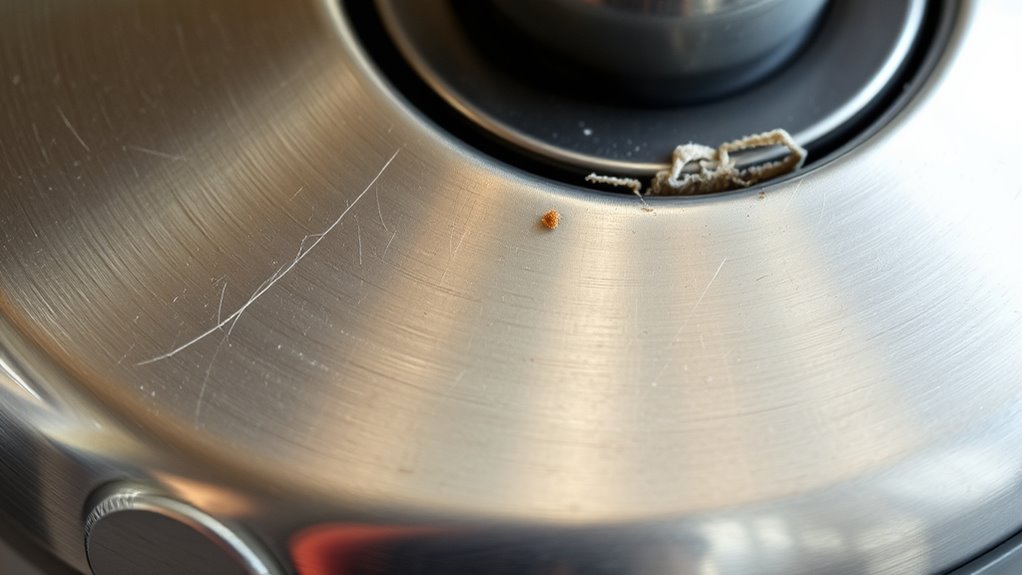
Regularly inspecting your ice cream maker for signs of wear and damage is essential to guarantee safe operation. Check for sensor malfunctions, such as unresponsive temperature controls or inconsistent mixing. These issues can indicate internal sensor damage, leading to unsafe temperatures and spoilage risks. Also, look for visible signs of damage like cracks, corrosion, or frayed cords, which can compromise electrical safety. Power surges might cause electrical components to malfunction or fail altogether; if your machine experiences unexpected shutdowns or irregular operation after a surge, it’s a red flag. Don’t ignore burning smells or unusual noises, as they can signal internal damage. Staying vigilant about these signs helps prevent accidents and ensures your ice cream maker remains safe to use.
Safe Handling of Electrical Components
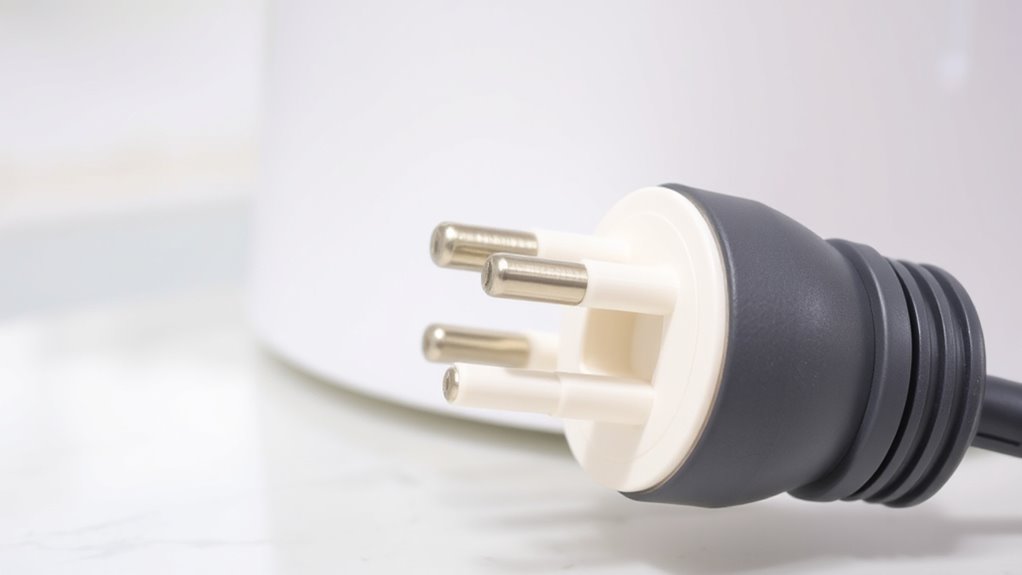
Handling electrical components safely is vital to prevent accidents and damage. Always unplug your ice cream maker before inspecting or cleaning electrical parts. Follow electrical safety guidelines to avoid shocks or short circuits. Proper cord management is essential; keep cords away from water, heat, and sharp objects. Use a stable outlet, and never overload circuits. Check that cords are in good condition, with no frays or exposed wires. When plugging in or unplugging, hold the plug, not the cord, to prevent damage. Keep cords neatly organized to avoid tripping hazards. Remember, a well-maintained electrical system reduces risks and prolongs your ice cream maker’s lifespan. Prioritize safety by handling electrical components with care and ensuring cords are managed properly at all times.
Ensuring Proper Storage and Usage Conditions
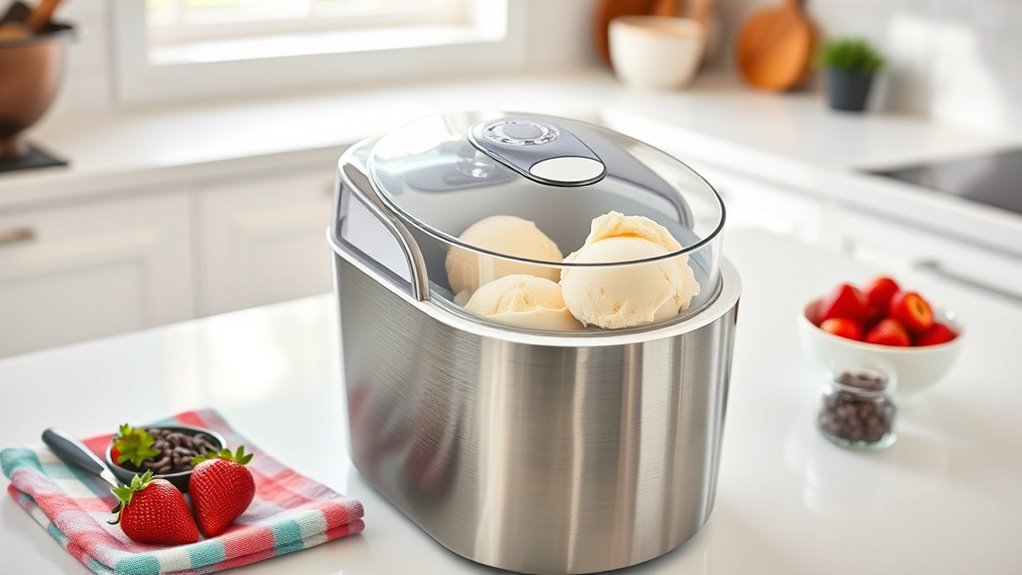
To keep your ice cream maker safe and effective, you need to maintain the correct freezer temperature and store components properly. Make sure to use suitable containers that won’t damage the machine or affect the quality of your ice cream. Always follow the manufacturer’s guidelines to guarantee safe operation and ideal results.
Maintain Freezer Temperature
Maintaining the correct freezer temperature is essential for keeping ice cream fresh and safe to consume. If your freezer isn’t set to the right temperature, the ice cream can become too soft or develop ice crystals, affecting its consistency. Ideally, keep your freezer at 0°F (-18°C) to ensure ideal preservation. Regularly check the temperature with a reliable thermometer to prevent fluctuations. A consistent freezer temperature helps maintain the ice cream’s smooth, creamy texture and prevents spoilage. Avoid opening the freezer frequently or leaving it open too long, as this can cause temperature spikes. By keeping your freezer properly chilled, you ensure your ice cream stays at its best quality, taste, and safety. Proper temperature control is key to enjoying your frozen treats without worry.
Use Suitable Containers
Choosing the right containers is essential for storing ice cream properly. Your container selection should prioritize material compatibility to prevent melting, cracking, or chemical reactions. Opt for food-grade, airtight containers that keep ice cream fresh and prevent freezer burn. Avoid using containers made of materials that aren’t designed for cold storage, such as thin plastics or non-food-safe plastics, which can crack or impart unwanted flavors. Metal or glass containers are excellent choices because they maintain temperature stability better than flimsy plastics. Ensure your containers are clean and dry before filling to prevent bacteria growth. Proper container selection not only preserves your ice cream’s texture and flavor but also guarantees safe storage conditions, reducing the risk of contamination or spoilage.
Follow Manufacturer Guidelines
Following the manufacturer’s guidelines is essential for guaranteeing your ice cream maker operates safely and produces the best results. Properly following instructions helps maintain ingredient safety by preventing contamination and spoilage. It also ensures you use the machine correctly, avoiding damage that could void your warranty coverage. Always store ingredients as recommended and avoid overfilling the machine, which can cause malfunctions. Pay attention to recommended cleaning procedures to prevent mold and bacteria growth. Using your ice cream maker according to the manufacturer’s instructions minimizes safety risks and prolongs its lifespan. Keep track of any updates or tips provided by the manufacturer to optimize performance. By adhering to these guidelines, you protect yourself and your investment, ensuring safe, delicious ice cream every time.
Recognizing When to Replace Your Ice Cream Maker
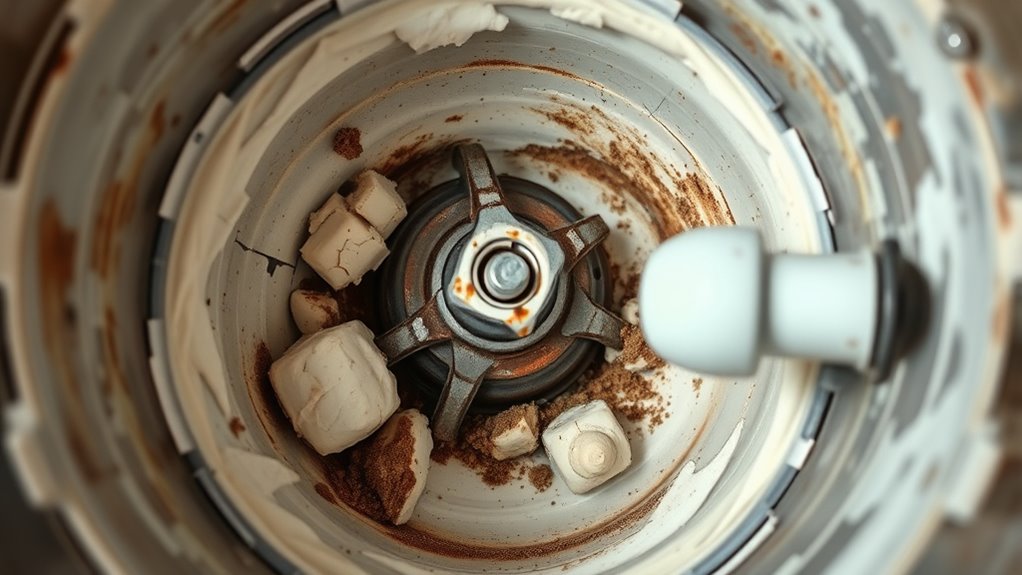
Eventually, your ice cream maker will show signs it’s time for a replacement. Over time, wear and tear can compromise ice cream safety, making continued use risky. If you notice persistent strange noises, leaks, or the machine struggles to reach proper freezing temperatures, it’s a clear sign it’s nearing the end of its machine lifespan. Cracks or damaged electrical cords also pose safety hazards. Relying on an aging machine can lead to inconsistent results or even safety issues. Regularly assess your unit’s performance, and don’t hesitate to replace it if repairs seem frequent or costly. Prioritizing safety guarantees you enjoy delicious ice cream without risking malfunctions or accidents. When in doubt, a newer model can offer improved safety features and longer-lasting performance.
Frequently Asked Questions
Can I Use My Ice Cream Maker Outdoors Safely?
You can use your ice cream maker outdoors, but you need to consider outdoor temperature and weather conditions. Avoid operating it in direct sunlight or when temperatures are too hot, as high heat can affect freezing and motor performance. Also, make sure it’s not exposed to rain or moisture, which could damage the machine. Always check the manufacturer’s guidelines for outdoor use to ensure safety and ideal ice cream quality.
Are There Any Health Risks From Old or Damaged Parts?
While it’s tempting to overlook minor signs of aging, old or damaged parts can subtly pose health risks. Material degradation may lead to contamination risks, affecting your ice cream’s safety and flavor. Worn seals or cracked components might harbor bacteria or mold. To enjoy your treats worry-free, regularly inspect your ice cream maker and replace any worn or damaged parts promptly, ensuring your device remains a safe and delightful kitchen companion.
Is It Safe to Use Homemade Cleaning Solutions?
Using homemade cleaning solutions can be safe if you prioritize chemical safety and follow proper DIY cleaning guidelines. You should avoid harsh or unknown ingredients that could damage your ice cream maker or leave harmful residues. Always research safe DIY cleaning recipes, test small areas first, and thoroughly rinse to prevent any chemical buildup. Remember, prioritizing chemical safety guarantees your appliance stays clean without risking health or damage.
How Do I Dispose of My Broken Ice Cream Maker?
Imagine your broken ice cream maker as a fallen hero needing respect. To properly dispose of it, first unplug and safely dismantle it, removing any sharp parts. Then, check local recycling options for metal or plastic components—think of it as giving your appliance a new purpose. Proper disposal guarantees safety and helps reduce waste, giving your once-beloved machine a responsible farewell and contributing to environmental health.
Can Children Operate the Ice Cream Maker Safely?
You shouldn’t let children operate the ice cream maker unsupervised. Always provide child supervision and follow safety precautions, like keeping hands away from moving parts and unplugging the machine after use. Teach kids about potential hazards, and make certain they understand the importance of following instructions. By supervising closely and emphasizing safety precautions, you help prevent accidents and keep your children safe while they enjoy making ice cream.
Conclusion
Now that you know the key safety tips, your ice cream maker can be a trusty companion for sweet adventures. Think of it as a loyal friend—if you care for it and heed its warning signs, it’ll serve you well for years. Remember, safety isn’t just a rule; it’s the secret ingredient to endless delicious memories. Keep it safe, keep it fun, and let your ice cream dreams come true!
